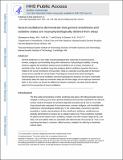Neural oscillations demonstrate that general anesthesia and sedative states are neurophysiologically distinct from sleep
Author(s)
Akeju, Oluwaseun; Brown, Emery Neal
DownloadAccepted version (508.6Kb)
Terms of use
Metadata
Show full item recordAbstract
General anesthesia is a man-made neurophysiological state comprised of unconsciousness, amnesia, analgesia, and immobility along with maintenance of physiological stability. Growing evidence suggests that anesthetic-induced neural oscillations are a primary mechanism of anesthetic action. Each anesthetic drug class produces distinct oscillatory dynamics that can be related to the circuit mechanisms of drug action. Sleep is a naturally occurring state of decreased arousal that is essential for normal health. Physiological measurements (electrooculogram, electromyogram) and neural oscillatory (electroencephalogram) dynamics are used to empirically characterize sleep into rapid eye movement sleep and the three stages of non-rapid eye movement sleep. In this review, we discuss the differences between anesthesia- and sleep-induced altered states from the perspective of neural oscillations.
Date issued
2017-05Department
Harvard University--MIT Division of Health Sciences and TechnologyJournal
Current Opinion in Neurobiology
Publisher
Elsevier BV
Citation
Akeju, Oluwaseun and Emery N Brown. "Neural oscillations demonstrate that general anesthesia and sedative states are neurophysiologically distinct from sleep." Current Opinion in Neurobiology, 44 (June 2017): 178-185 © 2017 Elsevier Ltd
Version: Author's final manuscript
ISSN
0959-4388
1873-6882